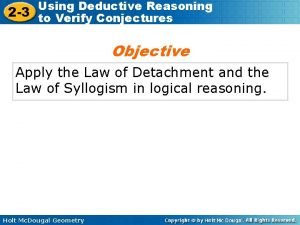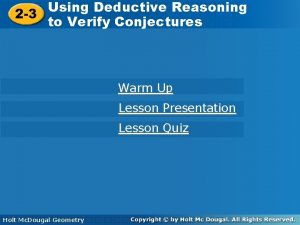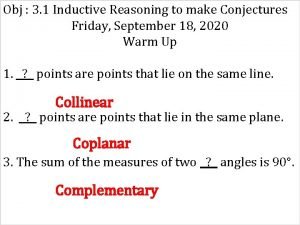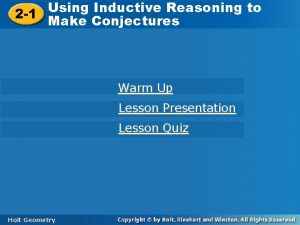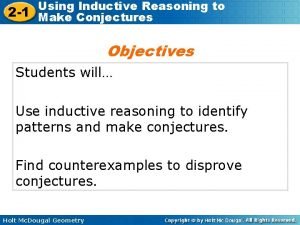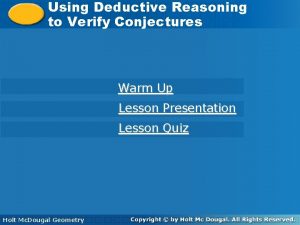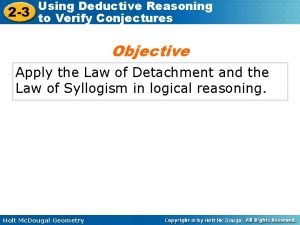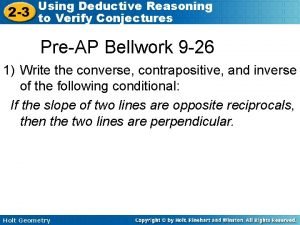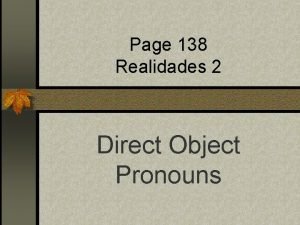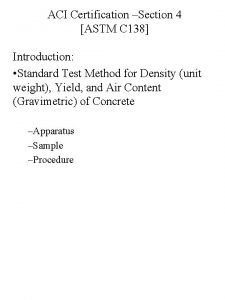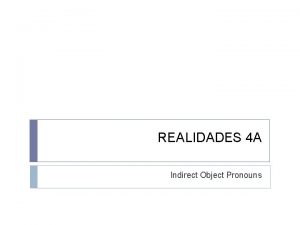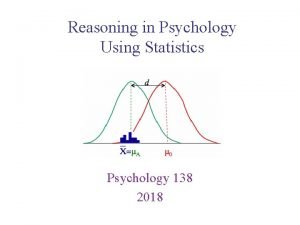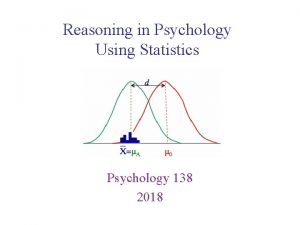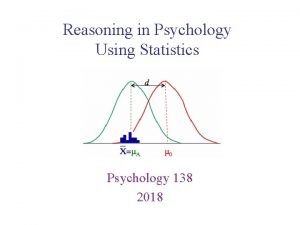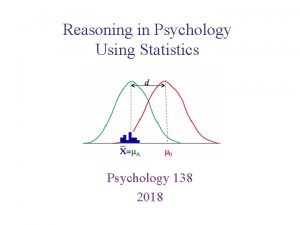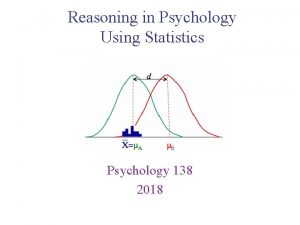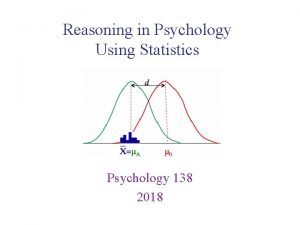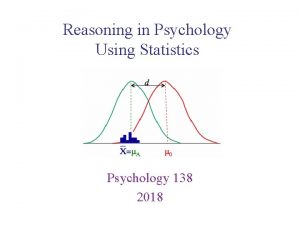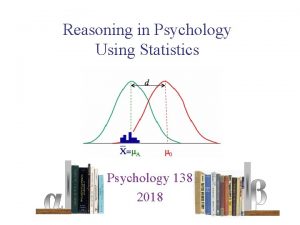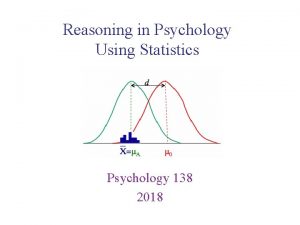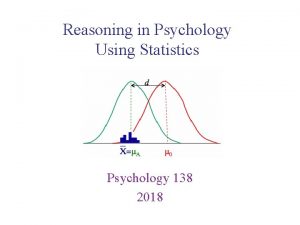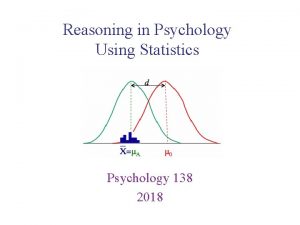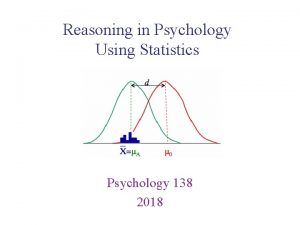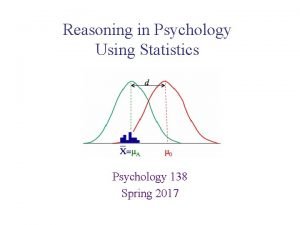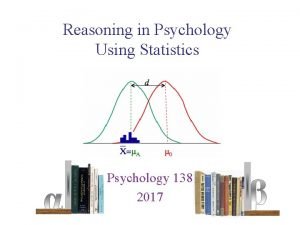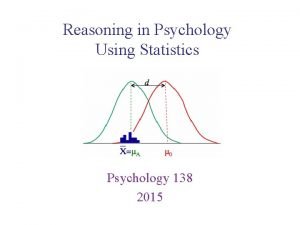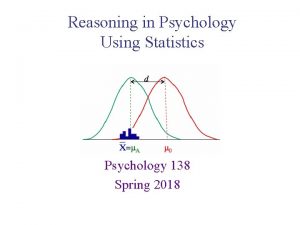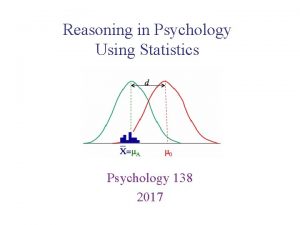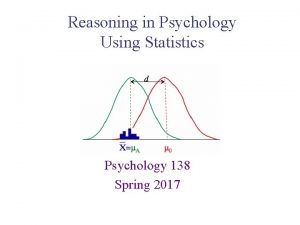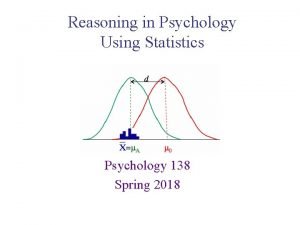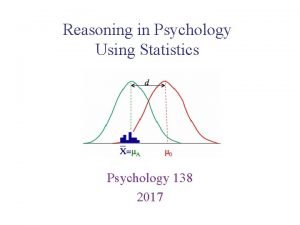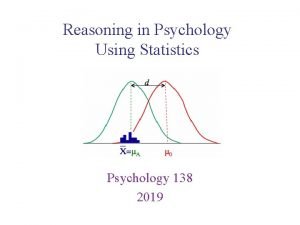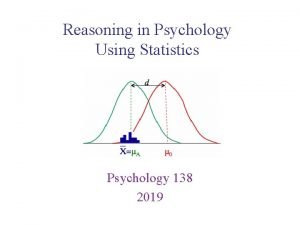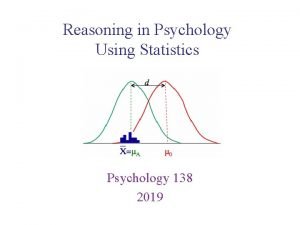Reasoning in Psychology Using Statistics Psychology 138 2018
































- Slides: 32

Reasoning in Psychology Using Statistics Psychology 138 2018

• Don’t forget quiz 8 due this Friday Annoucements Reasoning in Psychology Using Statistics

• The linear equation isn’t the whole thing – Also need a measure of error Y = X(. 5) + (2. 0) + error • Same line, but different relationships (strength difference) Y = X(. 5) + (2. 0) + error Y 6 5 4 3 2 1 1 2 3 4 5 6 X Measures of Error in Regression Reasoning in Psychology Using Statistics

• The linear equation isn’t the whole thing • Also need a measure of error • Three common measures of error – r 2 (r-squared) • R-squared (r 2) represents the percent variance in Y accounted for by X – Sum of the squared residuals = SSresidual= SSerror • Compute the difference between the predicted values and the observed values (“residuals”) • Square the differences • Add up the squared differences – Standard error of estimate Y 6 5 4 3 2 1 1 2 3 4 5 6 X Measures of Error in Regression Reasoning in Psychology Using Statistics by Jim: Standard Error of the Regression vs. R-squared

• Sum of the squared residuals = SSresidual = SSerror X 6 1 5 3 Y 6 2 6 4 3 2 mean 3. 6 4. 0 Y 6. 2 1. 6 6. 2 6 = (0. 92)(1)+0. 688 5. 3 5 4 5. 3 = (0. 92)(5)+0. 688 3. 45 3 3. 45 = (0. 92)(3)+0. 688 2 1. 6 3. 45 = (0. 92)(3)+0. 688 1 = (0. 92)(6)+0. 688 1 2 3 4 These are all points on the prediction line Measures of Error in Regression Reasoning in Psychology Using Statistics 5 6 X

• Sum of the squared residuals = SSresidual = SSerror X 6 1 5 3 Y 6 2 6 4 3 2 mean 3. 6 4. 0 residuals 6. 2 1. 6 5. 3 3. 45 -0. 20 2 - 1. 6 = 0. 40 6 - 5. 3 = 0. 70 4 - 3. 45 = 0. 55 2 - 3. 45 = -1. 45 Quick check 0. 00 6 - 6. 2 = Y 6 5 4 3 2 1 1 2 3 4 5 These are deviations between the points on the prediction line and the actual observed values (in the Y direction) Measures of Error in Regression Reasoning in Psychology Using Statistics 6 X

• Sum of the squared residuals = SSresidual = SSerror X 6 1 5 3 Y 6 2 6 4 3 2 mean 3. 6 4. 0 6. 2 1. 6 5. 3 3. 45 -0. 20 0. 40 0. 70 0. 55 -1. 45 0. 00 0. 04 0. 16 0. 49 0. 30 2. 10 3. 09 SSERROR Measures of Error in Regression Reasoning in Psychology Using Statistics

• Sum of the squared residuals = SSresidual = SSerror X 6 1 5 3 Y 6 2 6 4 3 2 mean 3. 6 4. 0 6. 2 1. 6 5. 3 3. 45 4. 0 -0. 20 0. 40 0. 70 0. 55 -1. 45 0. 00 4. 0 0. 0 4. 0 16. 0 SSY 0. 04 0. 16 0. 49 0. 30 2. 10 3. 09 SSERROR Don’t get these confused with each other Measures of Error in Regression Reasoning in Psychology Using Statistics

• Standard error of the estimate represents the average deviation from the line Y 6 5 4 3 2 1 df = n - 2 1 2 3 4 5 6 X Measures of Error in Regression Reasoning in Psychology Using Statistics

• SPSS Regression output gives you a lot of stuff • r 2 – percent variance in Y accounted for by X • Standard error of the estimate – the average deviation from the line • SSresiduals or SSerror Measures of Error in Regression Reasoning in Psychology Using Statistics

A manufacturer of watches takes a sample of 200 people. Each person is classified by age and watch type preference (digital vs. analog). Young (under 30) Old (over 30) The question: Is there a relationship between age and watch preference? Chi-Square Test for Independence Reasoning in Psychology Using Statistics

A manufacturer of watches takes a sample of 200 people. Each person is classified by age and watch type preference (digital vs. analog). Young (under 30) Old (over 30) The question: Is there a relationship between age and watch preference? Chi-Square Test for Independence Reasoning in Psychology Using Statistics

• Chi-square test of independence (χ2 lower-case chi ) – Describing the relationship between two categorical variables or Decision tree Reasoning in Psychology Using Statistics Young or Old

A manufacturer of watches takes a sample of 200 people. Each person is classified by age and watch type preference (digital vs. analog). The question: is there a relationship between age and watch preference? Chi-Squared Test for Independence Reasoning in Psychology Using Statistics

A manufacturer of watches takes a sample of 200 people. Each person is classified by age and watch type preference (digital vs. analog). The question: is there a relationship between age and watch preference? Step 1: State the hypotheses and select an alpha level – H 0: Preference is independent of age (“no relationship”) – HA: Preference is related to age (“there is a relationship”) – We’ll set α = 0. 05 Observed scores Chi-Squared Test for Independence Reasoning in Psychology Using Statistics

Step 2: Compute your degrees of freedom & get critical value df = (#Columns - 1) * (#Rows - 1) = (3 -1) * (2 -1) = 2 – Go to Chi-square statistic table and find the critical value • For this example, with df = 2, and α = 0. 05 • The critical chi-squared value is 5. 99 Chi-Squared Test for Independence Reasoning in Psychology Using Statistics

As df gets larger, need larger X 2 value for significance. Number of X 2 α =. 05 cells get larger. 5. 99 7. 81 11. 07 14. 07 Chi-Squared Test for Independence Reasoning in Psychology Using Statistics

Step 3: Collect the data. Obtain row and column totals (sometimes called the marginals) and calculate the expected frequencies Observed scores Chi-Squared Test for Independence Reasoning in Psychology Using Statistics

Step 3: Collect the data. Obtain row and column totals (sometimes called the marginals) and calculate the expected frequencies Observed scores Spot check: make sure the row totals and column totals add up to the same thing Chi-Squared Test for Independence Reasoning in Psychology Using Statistics

Step 3: Collect the data. Obtain row and column totals (sometimes called the marginals) and calculate the expected frequencies (in each cell) Observed scores Expected scores Digital 70 56 14 30 24 6 Analog Undecided Under 30 Over 30 Chi-Squared Test for Independence Reasoning in Psychology Using Statistics

Step 3: Collect the data. Obtain row and column totals (sometimes called the marginals) and calculate the expected frequencies (in each cell) Observed scores Expected scores 70 56 14 30 24 6 “expected frequencies” - if the null hypothesis is correct, then these are the frequencies that Digital Analog you would expect Undecided Under 30 Over 30 Chi-Squared Test for Independence Reasoning in Psychology Using Statistics

Step 4: compute the χ2 • Find the residuals (fo - fe) for each cell Chi-Squared Test for Independence Reasoning in Psychology Using Statistics

Step 4: compute the χ2 • Find the residuals (fo - fe) for each cell Computing the Chi-square Reasoning in Psychology Using Statistics

Step 4: compute the χ2 • Find the residuals (fo - fe) for each cell • Square these differences Computing the Chi-square Reasoning in Psychology Using Statistics

Step 4: compute the χ2 • Find the residuals (fo - fe) for each cell • Square these differences • Divide the squared differences by fe Computing the Chi-square Reasoning in Psychology Using Statistics

Step 4: compute the χ2 • Find the residuals (fo - fe) for each cell • Square these differences • Divide the squared differences by fe • Sum the results Computing the Chi-square Reasoning in Psychology Using Statistics

A manufacturer of watches takes a sample of 200 people. Each person is classified by age and watch type preference (digital vs. analog). The question: is there a relationship between age and watch preference? Step 5: Compare this computed statistic (38. 09) against the critical value (5. 99) and make a decision about your hypotheses here we reject the H 0 and conclude that there is a relationship between age and watch preference Chi-Squared, the final step Reasoning in Psychology Using Statistics

each cell = observed difference expected by chance Chi square as a statistical test Reasoning in Psychology Using Statistics

Analyze Reasoning in Psychology Using Statistics Descriptives Crosstabs Chi-Square Test in SPSS

Analyze Descriptives Crosstabs Click this to get bar chart of the results Reasoning in Psychology Using Statistics Click this to get the expected frequencies and residuals Chi-Square Test in SPSS

Chi-Square Test in SPSS Reasoning in Psychology Using Statistics

• In lab: Gain experience using and interpreting Chi-square procedures • Questions? • • Chi-squared test: https: //www. youtube. com/watch? v=WXPBo. FDq. NVk (~12 mins) Chi-squared test: https: //www. youtube. com/watch? v=Sv. Kv 375 sac. A (~38 mins) Chi-squared in SPSS: https: //www. youtube. com/watch? v=wf. If. EWMJY 3 s Chi-squared distribution: http: //onlinestatbook. com/2/chi_square/distribution. M. html Wrap up Reasoning in Psychology Using Statistics
 Inductive reasoning moves from
Inductive reasoning moves from Inductive argument
Inductive argument Example of inductive reasoning and deductive reasoning
Example of inductive reasoning and deductive reasoning Every quiz has been easy. therefore, the test will be easy.
Every quiz has been easy. therefore, the test will be easy. Inductive reasoning vs deductive reasoning geometry
Inductive reasoning vs deductive reasoning geometry Inductive reasoning patterns
Inductive reasoning patterns What is inductive method
What is inductive method Key stage 1 reasoning paper 2018
Key stage 1 reasoning paper 2018 Dada la siguiente secuencia rusia 2018 rusia 2018
Dada la siguiente secuencia rusia 2018 rusia 2018 Twitter statistics 2018
Twitter statistics 2018 Global exhibition industry statistics 2018
Global exhibition industry statistics 2018 Introduction to statistics what is statistics
Introduction to statistics what is statistics Using deductive reasoning to verify conjectures
Using deductive reasoning to verify conjectures Using inductive reasoning to make conjectures answers
Using inductive reasoning to make conjectures answers Using deductive reasoning to verify conjectures
Using deductive reasoning to verify conjectures Conjecture
Conjecture Using inductive reasoning to make conjectures
Using inductive reasoning to make conjectures Using inductive reasoning to make conjectures
Using inductive reasoning to make conjectures Using deductive reasoning to verify conjectures
Using deductive reasoning to verify conjectures Using deductive reasoning to verify conjectures
Using deductive reasoning to verify conjectures 2-3 using deductive reasoning to verify conjectures
2-3 using deductive reasoning to verify conjectures Salmo 138 6
Salmo 138 6 Direct object pronouns p.138
Direct object pronouns p.138 Yeus138
Yeus138 Hpd 136 uitm
Hpd 136 uitm Double.object pronouns spanish
Double.object pronouns spanish Adverb vs adjective examples
Adverb vs adjective examples Aci 138
Aci 138 Psalm 138: 1-3
Psalm 138: 1-3 Tiempo de orar salmo 138
Tiempo de orar salmo 138 Tec-138-702
Tec-138-702 Pg 138
Pg 138 Indirect object examples
Indirect object examples












